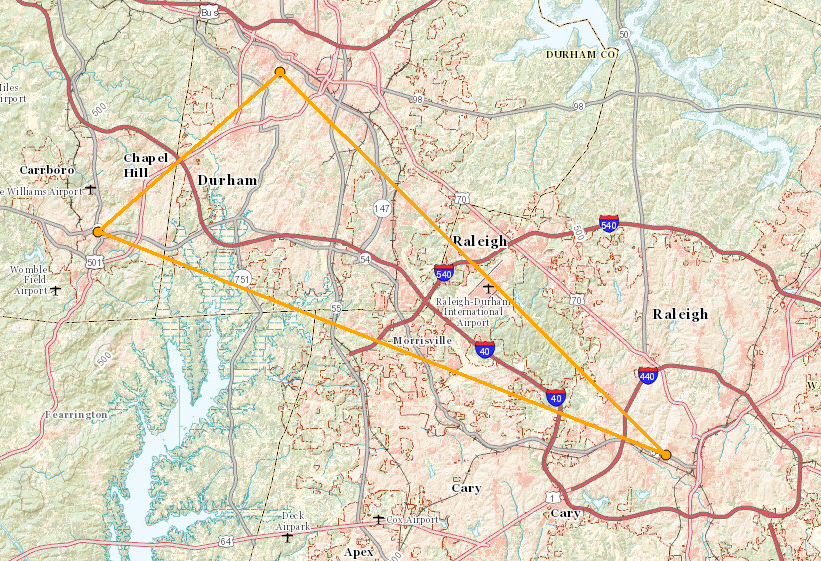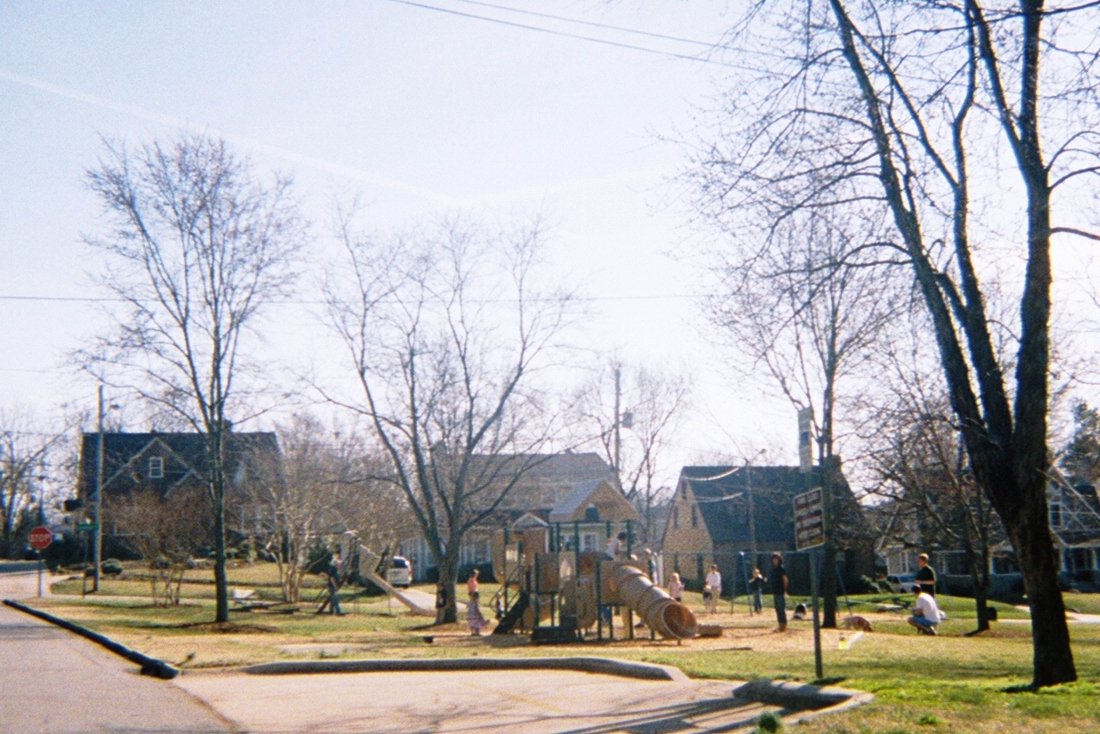|
Raleigh-Durham, North Carolina
The Research Triangle, or simply The Triangle, are both common nicknames for a metropolitan area in the Piedmont region of North Carolina in the United States, anchored by the cities of Raleigh and Durham and the town of Chapel Hill, home to three major research universities: North Carolina State University, Duke University, and University of North Carolina at Chapel Hill, respectively. The nine-county region, officially named the Raleigh–Durham–Cary combined statistical area (CSA), comprises the Raleigh–Cary and Durham–Chapel Hill Metropolitan Statistical Areas and the Henderson Micropolitan Statistical Area. The "Triangle" name originated in the 1950s with the creation of Research Triangle Park, located between the three anchor cities and home to numerous high tech companies. A 2019 Census estimate put the population at 2,079,687, making it the second largest combined statistical area in the state of North Carolina behind Charlotte CSA. The Raleigh–Durham te ... [...More Info...] [...Related Items...] OR: [Wikipedia] [Google] [Baidu] |
North Carolina's 4th Congressional District
The 4th congressional district of North Carolina is located in the central region of the state. The district includes all of Durham County, Orange County, Granville County, and Franklin County, as well as portions of Chatham County, northern Wake County, and southern Vance County. The district is currently represented by 11-term Congressman David Price, a former political science professor at Duke who was first elected in 1986, ousting one-term Republican incumbent Bill Cobey. Price was reelected in 1988, 1990, and 1992, but he was defeated in his bid for a fifth term in 1994 by Republican Fred Heineman, the Raleigh Police Chief, in a generally bad year for Democrats in North Carolina. Price came back to defeat Heineman in a rematch in 1996, and has been reelected each time since then by large margins, usually with more than 60% of the vote. In 2020, Price received 67% of the votes (332,421 votes) to defeat Republican challenger Robert Thomas, who received 33% (161,298 vote ... [...More Info...] [...Related Items...] OR: [Wikipedia] [Google] [Baidu] |
Person County, North Carolina
Person County is a county located in the U.S. state of North Carolina. The population was 39,097 as of the 2020 census. The county seat is Roxboro. Person County is included in the Durham-Chapel Hill Metropolitan Statistical Area, which is also included in the Raleigh-Durham-Chapel Hill Combined Statistical Area, which had an estimated population of 2,079,687 in 2019. It is located in the Piedmont region of North Carolina. History The colonial government established Person County as part of Edgecombe County in 1746. County designations kept changing, and it was part of Granville County from 1746 to 1752; included in Orange County until 1778; and part of Caswell County until 1791/1792. By dividing Caswell County into two squares–each side measuring approximately twenty (20) miles in length, the state formed two counties of each. The county was named after Brigadier General Thomas Person, a Revolutionary War patriot, who made significant contributions to Person County and ... [...More Info...] [...Related Items...] OR: [Wikipedia] [Google] [Baidu] |
Lee County, North Carolina
Lee County is a county located in the U.S. state of North Carolina. As of the 2020 census, the population was 63,285. The county seat is Sanford. It was established on March 6, 1907, from parts of Chatham and Moore counties, and named for General Robert E. Lee, who served as the General in Chief of the Armies of the Confederate States in 1865. Lee County comprises the Sanford Micropolitan Statistical Area, which is a part of the Fayetteville Combined Statistical Area, also known as the Fayetteville area, which had a 2019 estimated population of 854,826. Lee County's motto is "Committed Today for a Better Tomorrow". Geography According to the U.S. Census Bureau, the county has a total area of , of which is land and (1.6%) is water. State and local protected areas/sites * Buckhorn Dam * White Pines Nature Preserve (part) Major water bodies * Big Governors Creek * Cape Fear River * Cypress Creek * Deep River * Juniper Creek (Cape Fear River tributary) * Lake Tra ... [...More Info...] [...Related Items...] OR: [Wikipedia] [Google] [Baidu] |
Johnston County, North Carolina
Johnston County is a county located in the U.S. state of North Carolina. As of the 2020 census, the population was 215,999. Its county seat is Smithfield. Johnston County is included in the Raleigh, NC Metropolitan Statistical Area, which is also included in the Raleigh-Durham-Chapel Hill, NC Combined Statistical Area, which has a population of 1,998,808 as of U.S. Census 2012 Population Estimates. History The county was formed in 1746 from Craven County. It was named for Gabriel Johnston, Governor of North Carolina from 1734 to 1752. In 1752 parts of Johnston County, Bladen County, and Granville County were combined to form Orange County. In 1758 the eastern part of Johnston County became Dobbs County. In 1770 parts of Johnston County, Cumberland County, and Orange County were combined to form Wake County. Finally, in 1855 parts of Johnston County, Edgecombe County, Nash County, and Wayne County were combined to form Wilson County. Most early growers in Johnston County wer ... [...More Info...] [...Related Items...] OR: [Wikipedia] [Google] [Baidu] |
Granville County, North Carolina
Granville County is a county located on the northern border of the U.S. state of North Carolina. As of the 2020 census, the population was 60,992. Its county seat is Oxford. Granville County encompasses Oxford, NC Micropolitan Statistical Area, which is also included in the Raleigh-Durham-Chapel Hill, NC Combined Statistical Area. The county has access to Kerr Lake and Falls Lake and is part of the Roanoke, Tar and Neuse River watersheds. History The county was formed by English colonists in 1746 from Edgecombe County. It was named for John Carteret, 2nd Earl Granville, who as heir to one of the eight original Lords Proprietors of the Province of Carolina, claimed one eighth of the land granted in the charter of 1665. The claim was established as consisting of approximately the northern half of North Carolina, and this territory came to be known as the Granville District, also known as Oxford. In 1752, parts of Granville, Bladen, and Johnston counties were combined to ... [...More Info...] [...Related Items...] OR: [Wikipedia] [Google] [Baidu] |
Franklin County, North Carolina
Franklin County is a county located in the U.S. state of North Carolina. As of the 2020 census, the population was 68,573. Its county seat is Louisburg. Franklin County is included in the Raleigh, NC Metropolitan Statistical Area, which is also included in the Raleigh-Durham-Chapel Hill, NC Combined Statistical Area, which had a 2019 estimated population of 2,079,687. History The county was formed in 1779 from the southern half of Bute County. It is named for Benjamin Franklin. It is a part of the Research Triangle. County formation timeline * 1664 Albemarle County formed (original, extinct) * 1668 Albemarle County subdivided into Carteret, Berkeley, & Shaftesbury Precincts * 1681 Shaftesbury Precinct renamed Chowan Precinct * 1722 Bertie Precinct formed from Chowan Precinct * 1739 Bertie Precinct becomes Bertie County * 1741 Edgecombe County formed from Bertie County * 1746 Granville County formed from Edgecombe County * 1754 Creation of Bertie Precinct, Edgecombe Cou ... [...More Info...] [...Related Items...] OR: [Wikipedia] [Google] [Baidu] |
Durham County, North Carolina
Durham County is a county located in the U.S. state of North Carolina. As of the 2020 census, the population was 324,833, making it the sixth-most populous county in North Carolina. Its county seat is Durham, which is the only incorporated municipality predominantly in the county, though very small portions of cities and towns mostly in neighboring counties also extend into Durham County. The central and southern parts of Durham County are highly urban, consisting of the city as well as several unincorporated suburbs. Southeastern Durham County is dominated by the Research Triangle Park, most of which is in Durham County. The northern third of Durham County is rural in nature. Durham County is the core of the Durham-Chapel Hill, NC Metropolitan Statistical Area, which is also included in the Raleigh-Durham-Cary, NC Combined Statistical Area, which had a population of 2,106,463 in 2020. History The county was formed on April 17, 1881, from parts of Orange County and Wake ... [...More Info...] [...Related Items...] OR: [Wikipedia] [Google] [Baidu] |
Chatham County, North Carolina
Chatham County ( ) , from the North Carolina Collection's website at the . Retrieved 2012-09-25. is a located in the area of the U.S. state of . As of the [...More Info...] [...Related Items...] OR: [Wikipedia] [Google] [Baidu] |
High Point, North Carolina
High Point is a city in the Piedmont Triad region of the United States, U.S. state of North Carolina. Most of the city is in Guilford County, North Carolina, Guilford County, with parts extending into Randolph County, North Carolina, Randolph, Davidson County, North Carolina, Davidson, and Forsyth County, North Carolina, Forsyth counties. High Point is North Carolina's only city that extends into four counties. As of the 2020 United States census, 2020 census the city had a total population of 113,887 with an estimated population of 114,086 in 2021. High Point is the List of municipalities in North Carolina, ninth-largest municipality in North Carolina, the third-largest municipality in the Piedmont Triad, Piedmont Triad metropolitan area, and the 259th-largest city in the U.S. Major industries in High Point include furniture, textiles, and bus manufacturing. The city's official slogan is "North Carolina's International City" due to the semi-annual High Point Furniture Market t ... [...More Info...] [...Related Items...] OR: [Wikipedia] [Google] [Baidu] |
Winston-Salem, North Carolina
Winston-Salem is a city and the county seat of Forsyth County, North Carolina, United States. In the 2020 census, the population was 249,545, making it the second-largest municipality in the Piedmont Triad region, the 5th most populous city in North Carolina, the third-largest urban area in North Carolina, and the 90th most populous city in the United States. With a metropolitan population of 679,948 it is the fourth largest metropolitan area in North Carolina. Winston-Salem is home to the tallest office building in the region, 100 North Main Street, formerly known as the Wachovia Building and now known locally as the Wells Fargo Center. In 2003, the Greensboro-Winston-Salem-High Point metropolitan statistical area was redefined by the OMB and separated into the two major metropolitan areas of Winston-Salem and Greensboro-High Point. The population of the Winston-Salem metropolitan area in 2020 was 679,948. The metro area covers over 2,000 square miles and spans the five cou ... [...More Info...] [...Related Items...] OR: [Wikipedia] [Google] [Baidu] |
Greensboro, North Carolina
Greensboro (; formerly Greensborough) is a city in and the county seat of Guilford County, North Carolina, United States. It is the third-most populous city in North Carolina after Charlotte and Raleigh, the 69th-most populous city in the United States, and the largest city in the Piedmont Triad metropolitan region. At the 2020 census, its population was 299,035. Three major interstate highways (Interstate 40, Interstate 85, and Interstate 73) in the Piedmont region of central North Carolina were built to intersect at this city. In 1808, Greensborough (the spelling before 1895) was planned around a central courthouse square to succeed Guilford Court House as the county seat. The county courts were thus placed closer to the county's geographical center, a location more easily reached at the time by the majority of the county's citizens, who traveled by horse or on foot. In 2003, the previous Greensboro–Winston-Salem– High Point metropolitan statistical area was redefin ... [...More Info...] [...Related Items...] OR: [Wikipedia] [Google] [Baidu] |

.png)

